Twenty years ago this week, 8000 Bosnian Muslims were murdered in and around Srebrenica. A few months after the event I was a member of the BBC Panorama that went to investigate persistent rumours and reports of the massacre. It was still raw, no one had a clear idea of the extent of the crime. I’ve dusted off my diary and here are a few short extracts recording one of the first investigations of the crime, a crime the like of which I didn’t think to witness in Europe in my life time. The evidence we collected was used by the the War Crimes Tribunal in the Hague.
Tuesday 30 January 1996 [Tusla]
‘….Our first port of call today was the demonstration by the women of Srebrenica, in front of the UNHCR building.
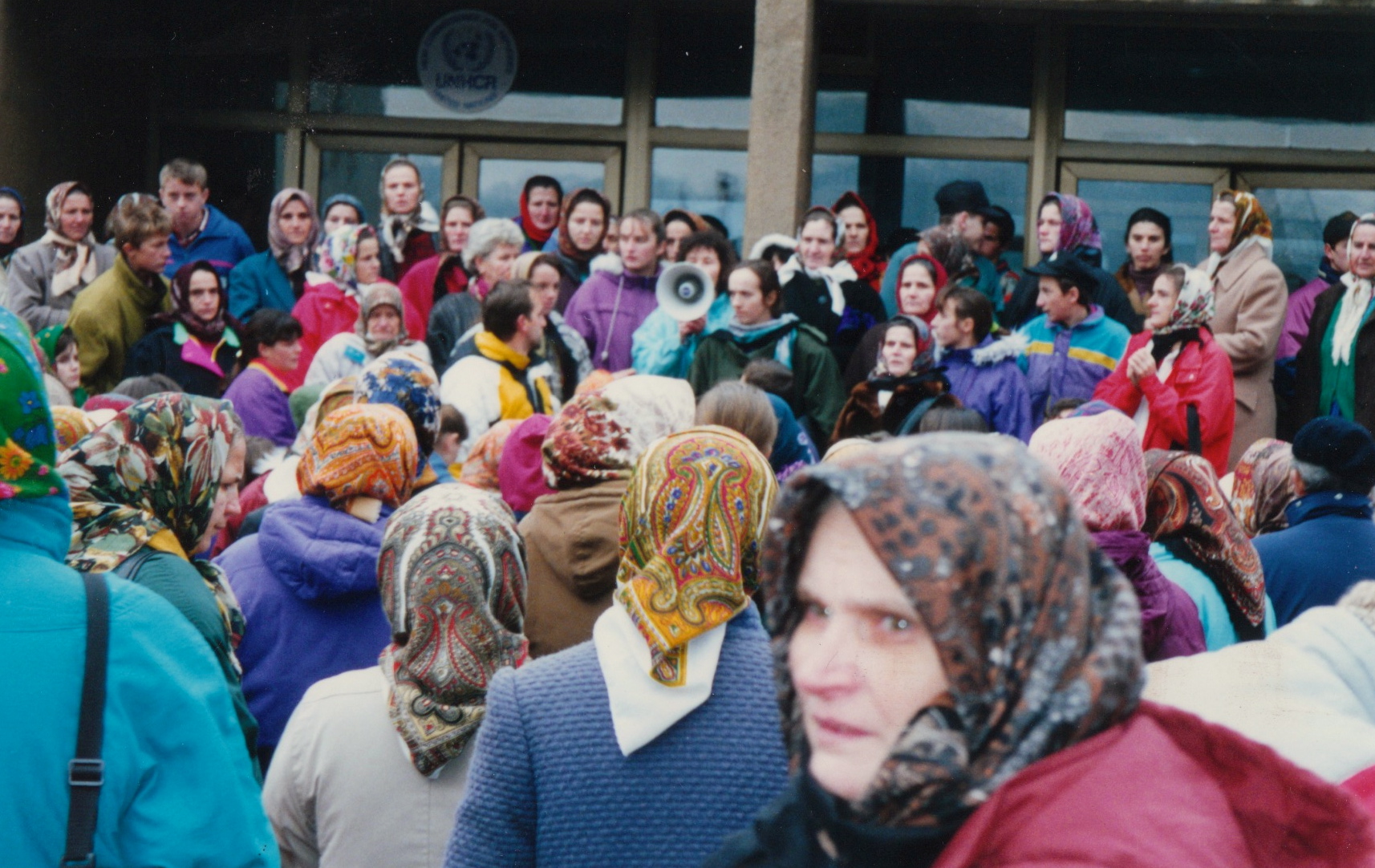
The Srebrenica women protest at UNHCR in Tusla
It was highly charged – Muslim but very European women, desperate to find their men folk, were demanding action and threatening a woman’s march to Srebrenica. Although the demonstration appeared to be orchestrated, the 100 or so women who gathered there were clearly genuinely concerned and grieving. Tears were shed by many in the crowd. Those we spoke to – through Vera our translator – talked of their men still alive, working in mines near Srebrenica for the Serbs. It seemed very unlikely. The women of Srebrenica were colourful, emotional, animated and spoke of a rich country tradition and culture, very much at odds with the drab grey surroundings of Tusla. They were miles from their home. One woman we interviewed in particular – Hiba Hussainovic– made a great impression on me.
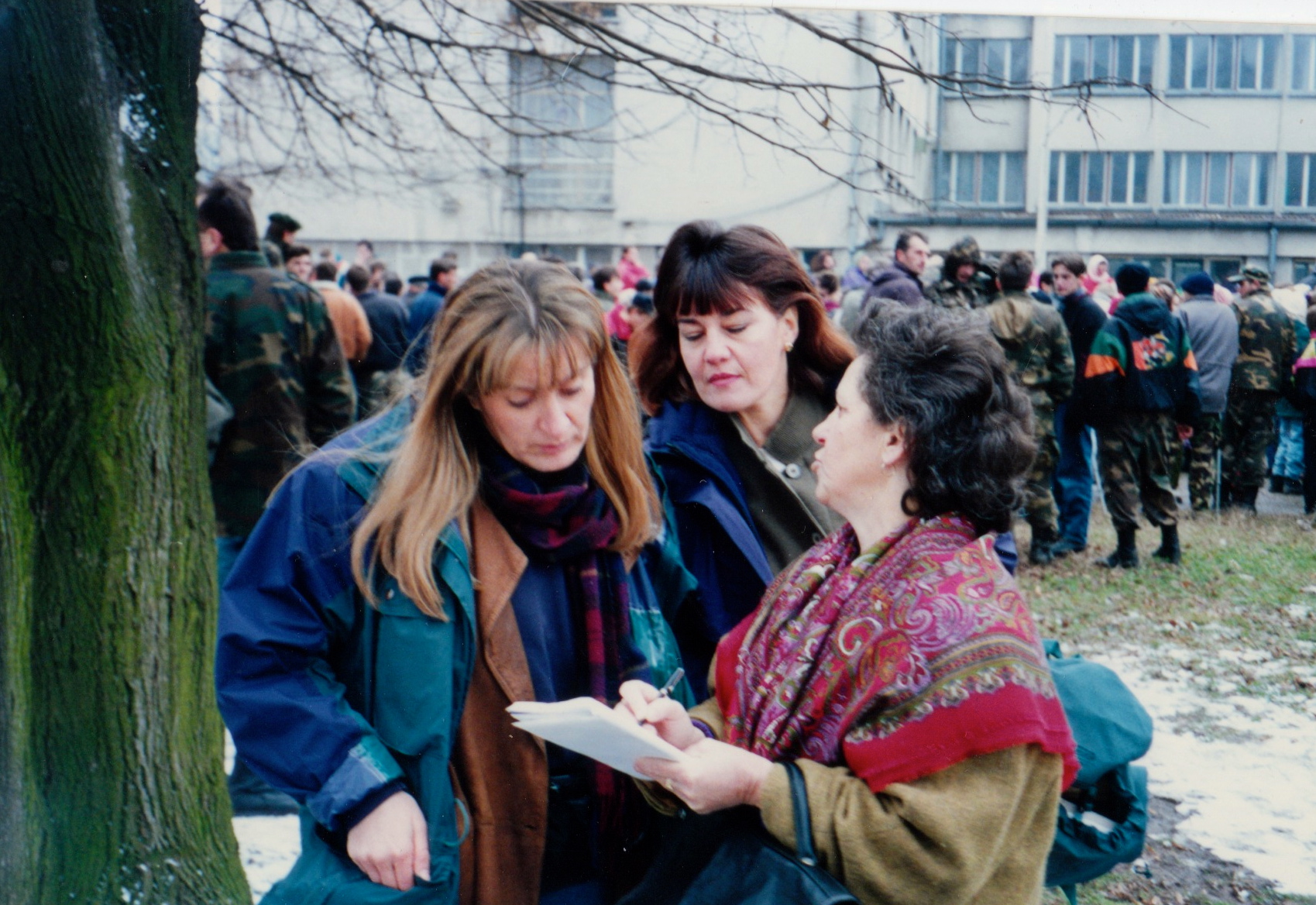
Hiba speaks to Jane and Vera
She had lost her husband and many other family members. Her home was close to the U.N. base at Potocari and she’d witnessed the loading of the refugees on to buses by the Serbs and the separation of the men from the women – and later she saw bodies and heard screams.… Later, we visited a refugee centre in a school. In the biology room – by no means large – we found 30 people, including Mevludin Oric and his family. He is a star witness, and Vera has done incredibly well to track him down. We filmed the dark, dingy room that is home to the elderly and the new born, stacked with food aid, blankets, bunk beds – incredibly clean and ordered, with so many families in such close proximity. They will all be relocated in time to a former Serb village, no doubt. Mevludin Oric has an extraordinary story to tell. He’d escaped with the other fighters on July 10\11 but was caught after a battle on the road. He was taken with many others to an execution site, but survived the shootings by hiding under bodies. He witnessed General Mladic [The Bosnian Serb Army Commander]’s visit – evidence that places the general at the site of a war crime. Not surprisingly, having lost his father and brothers – we met his grieving mother – he is adamant the war will continue, ‘once we’ve got the arms’. We’d taken him to the hotel for the interview and it meant driving him back through the snow and ice to the refugee camp. He wouldn’t take a taxi at night – he is too frightened that people will kill him to stop him giving evidence about the massacre and the role of General Mladic…..
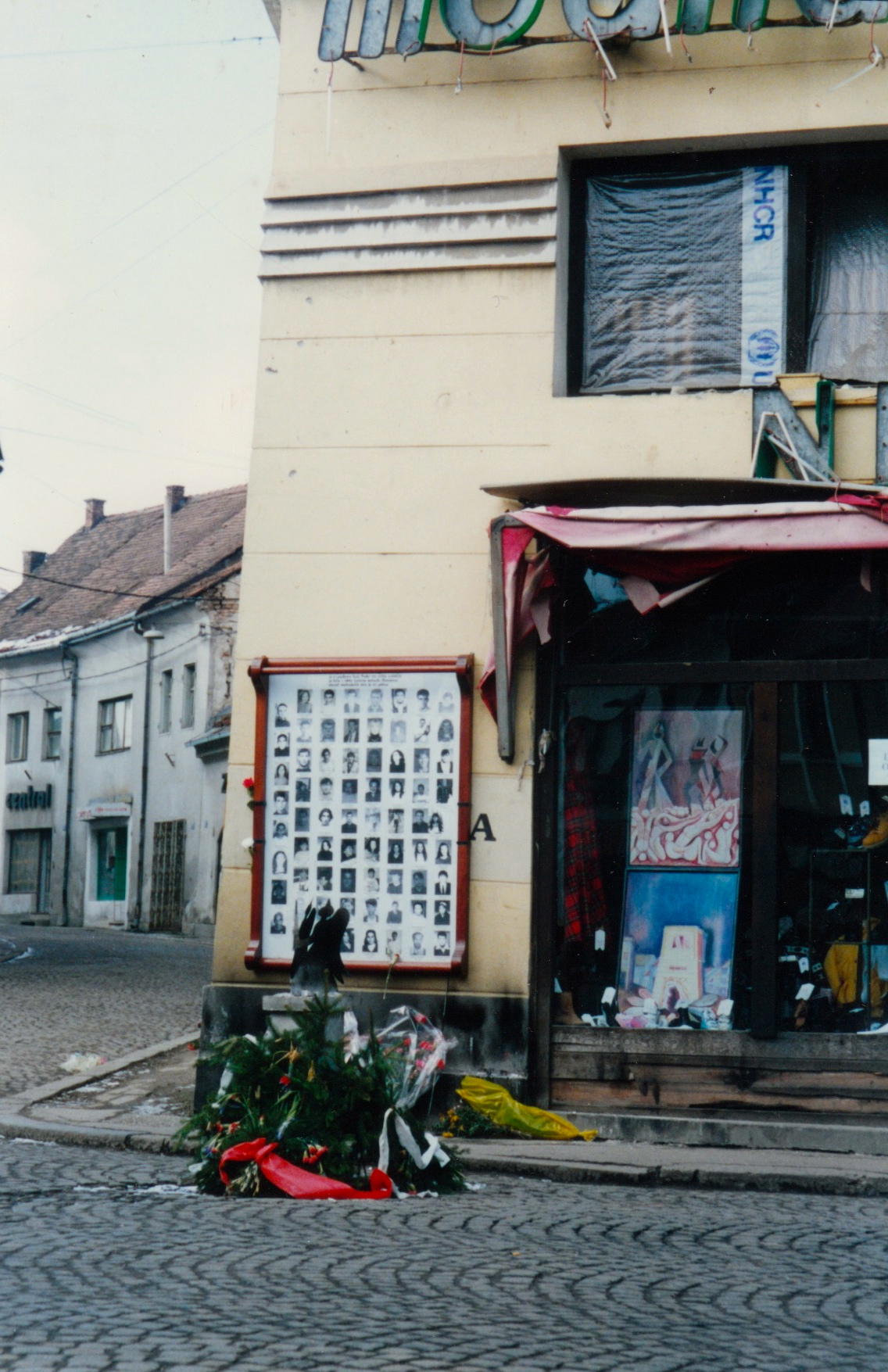
A street corner shrine in Tusla where where 76 Bosnian Muslims were killed by a mortar
Wednesday 31st [Tusla]
‘….pretty heavy session with Hassan, the translator for the UN Dutch Battalion in Srebrenica [Potocari]. He told his story in English then gave us a diagram of the Dutch compound at Potocari and reviewed some footage of the 13th July shot by a freelancer at the time. He was really very calm, and hearing his story, it was me who felt real indignation. Indignation for his lost parents and brother, and sympathy for his struggle to protect his brother. His brother was 21 and he was clearly marked by the Serbs as a future threat. He received no support from the Dutch, for whom he’d worked for years. These were the soldiers who cowered in their bunker while Bosnians were being forced to leave, five at a time, along a route carefully marked out by striped tape – from warehouse into the compound, to the main gate, where the Serbs with German Shepherds were eagerly waiting. Hassan’s parents joined the rest. His father, who had been involved in the negotiations, was offered asylum by the Dutch at the last minute, but refused to leave his wife and son. Hassan still hopes they’re alive – if only I could share his confidence…’
February 1st [Tusla]
‘…. in the afternoon we interviewed Enver – the boy seen in a snatch of freelance video that has emerged of the scene – we finally managed to track him down.
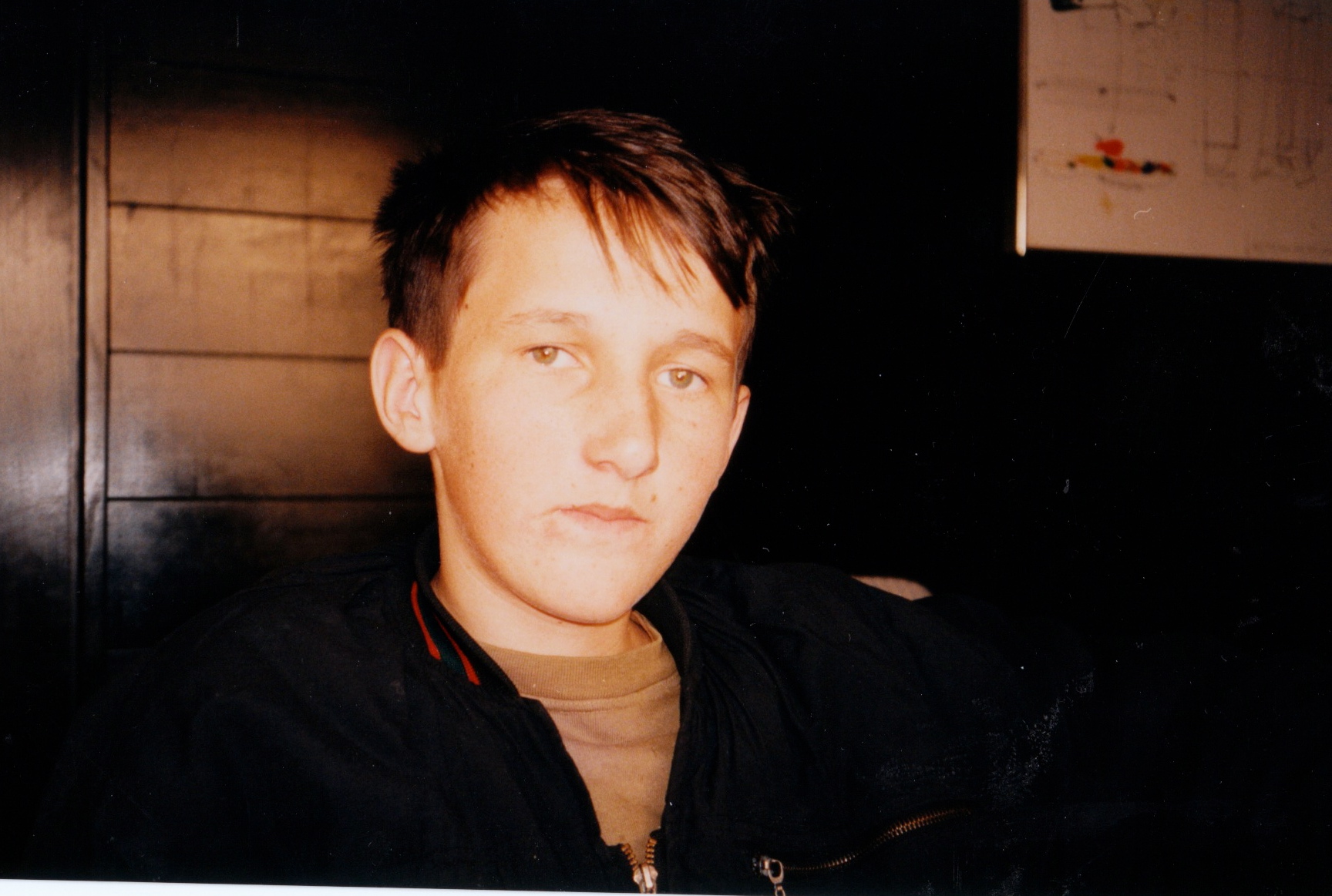
Enver
He’s 17 now – 16 when he joined the Muslim men before the fall of the Srebrenica on their trek to escape to Tusla. He’d been among those ambushed. The Serb forces were raining shell fire on to the hill side where they were surrounded and he decided to surrender, along with many others. He wasn’t a soldier. A Serb cameraman caught his young and frightened face coming down from the hills. It appears all those who surrendered with him have died. He was asked to get some water from a spring, in the mean time the men with him were executed. The same fate was to happen to him when a Serb soldier intervened. In the end he was allowed to go and join the women, who hid him as they went through other Serb checkpoints…..’
February 2-3 [Sarajevo]
‘…my hotel bedroom here overlooks the famous twin towers, gutted and burnt – well not quite. A few hardy people are working in the bottom of one of the towers – the lights are still on there. Shots of these towers under fire and burning are famous throughout the world. The first room the hotel gave me made them seem particularly close because there was no glass in the window. The room was filled with the roar of IFOR helicopters overhead. Room 522 is quieter, thank to the glass. It was an amazing drive here, through the valleys of central Bosnia, passed countless ethnically cleansed villages, through the wrecked suburbs of Sarajevo, along sniper alley, into the city. It appears quiet but expectant after three years of siege – is it all over? [The siege of the city officially ended three weeks later] The people think not. Here in battle scarred Sarajevo I can see why they have so little confidence. It was extraordinary driving along that famous route into the city, through the checkpoints, the moon very full, hanging over the jagged outlines of the shellacked buildings [to use a David Owenism]…..
We started from Tusla at about 11 a.m. …. We had a local man to guide us, thankfully. He’d gone to find the village where our interviewee lived the day before and knew how to direct us there. All along the route small villages, road side houses destroyed, pock marked with heavy machine gun and shell fire. Two waves of ethnic cleansing, first of Muslims by Serbs, then of Serbs by Muslims, as recently as three months ago. Our interviewee lived in a Serb mountain village. He told us of how he’d escaped death by the skin of his teeth as the Serbs slaughtered those around him and dug their graves.
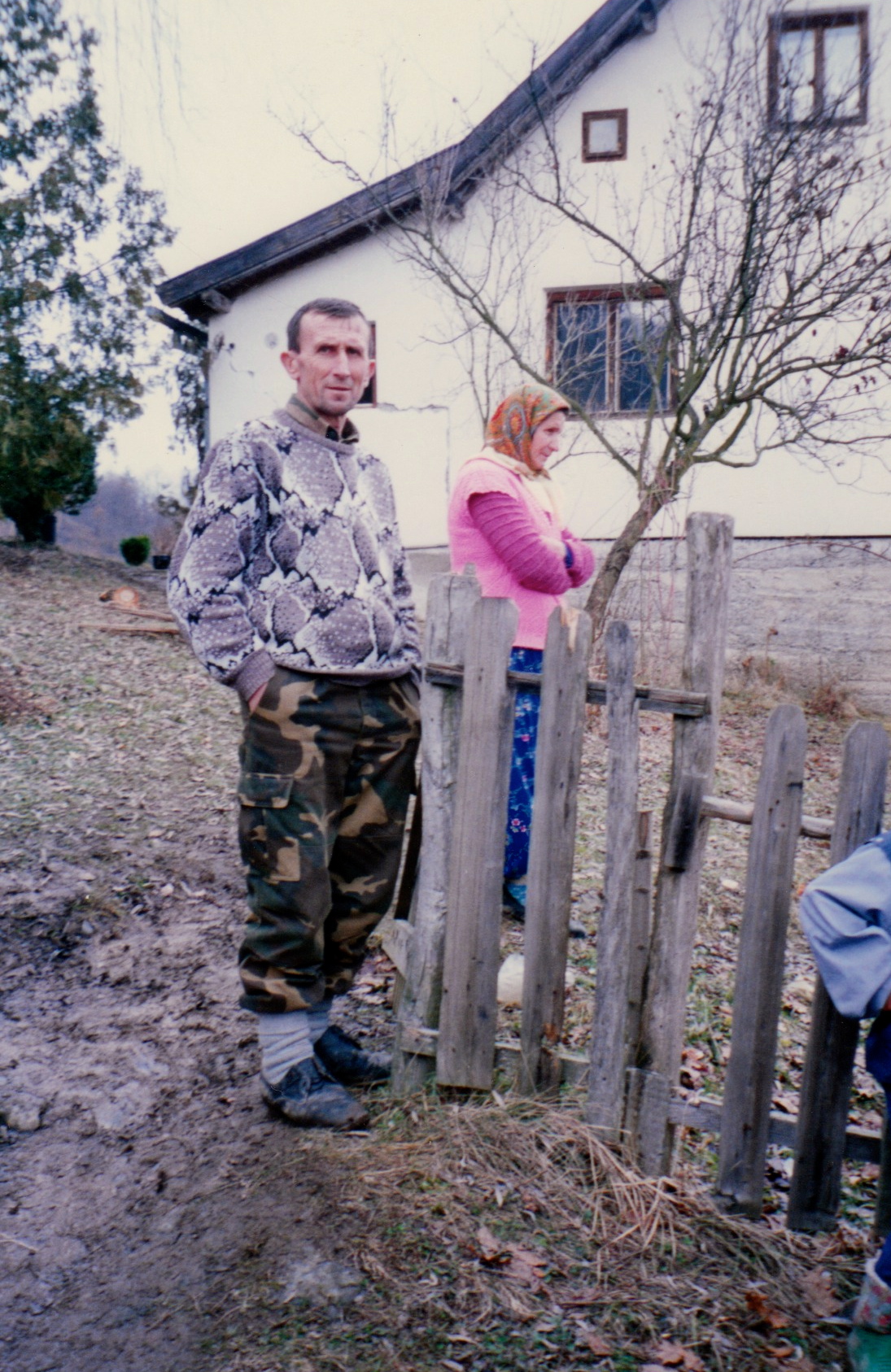
Hakjir Huseinovic and his wife
From there we drove along the rough road to Zivanice, along roads strung with yellow tape to warn of hastily laid roadside mines – a leaving present from the Serbs. From Zivanice we were forced to take a detour. The bridge on the road to Sarajevo was down, something we only discovered after we managed to weave our way through the tank traps and rubble to the space across the river where it used to be. Driving in to Sarajevo we passed through the Serb suburb of Ilijas, and beyond this, the familiar scenes of destruction – a no man’s land of buildings laid to waste. I understand from Vera there has been the first American casualty of the war. He stood on a land mine hidden in a grass verge on a road I drove along near Tusla yesterday. You never know… that thought crossed my mind as I was fiddling with the Land Rover outside the hotel after dark, the wall it was parked in front of peppered with bullet holes.
February 4 [Sarajevo and Srebrenica]
Again to my diary, head thick with sleep. Six hours behind the wheel of that ***** of a Land Rover, swaying all the way to Srebrenica. We travelled through Serb villages, similar to all the Muslim ones we’d seen the day before – stooks outside, neat houses with balconies, horse drawn carts – in some cases drawn by bullocks. After the convoy had wound down the mountain into the Drina valley and through the Serb checkpoints, we were on the road to Bratunic and Srebrenica. In the Drina valley we drove passed house after house that had been trashed, as first Muslims then Serbs worked their way up it. Every 100 yards a house gutted, because the ethnic cleansing has been particularly vicious here. All of it paled into insignificance by the time we reached Potocari and Srebrenica. The town was wrecked. Piles of belongings, wet and rotting, lining the streets – books, identity documents, photo albums, three piece suites – the belongings of the Muslim families that the Serb soldiers were not interested in looting.
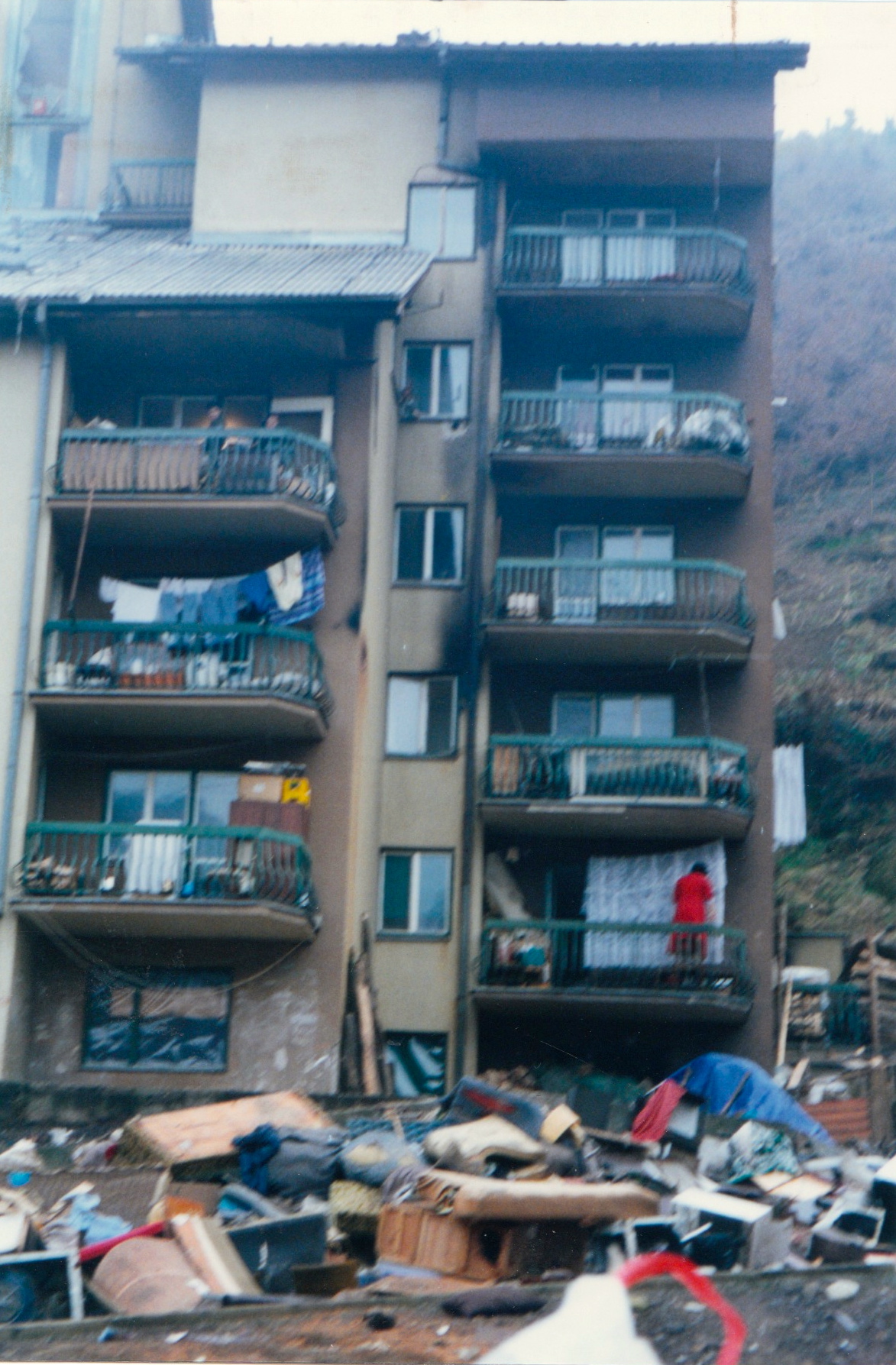
There are a few Serbs now, settled from Bihac and Banja Luka etc.. Trying to find a decent home in Srebrenica – that’s one with four walls and a roof – isn’t easy. A pony trap passed as we were filming the town and its driver pointed to his animal, ‘arrest this one’, he said, ‘the United Nations will be interested in this one’. We drove down to Potocari, our Croat fixer, Vera, very nervous. She tried to laugh it off and said her name was the same as a Chetnik leader – Korazic – so she would be all right, because ‘he was responsible for at least a thousand deaths’. We were certainly watched with interest by the Serbs.
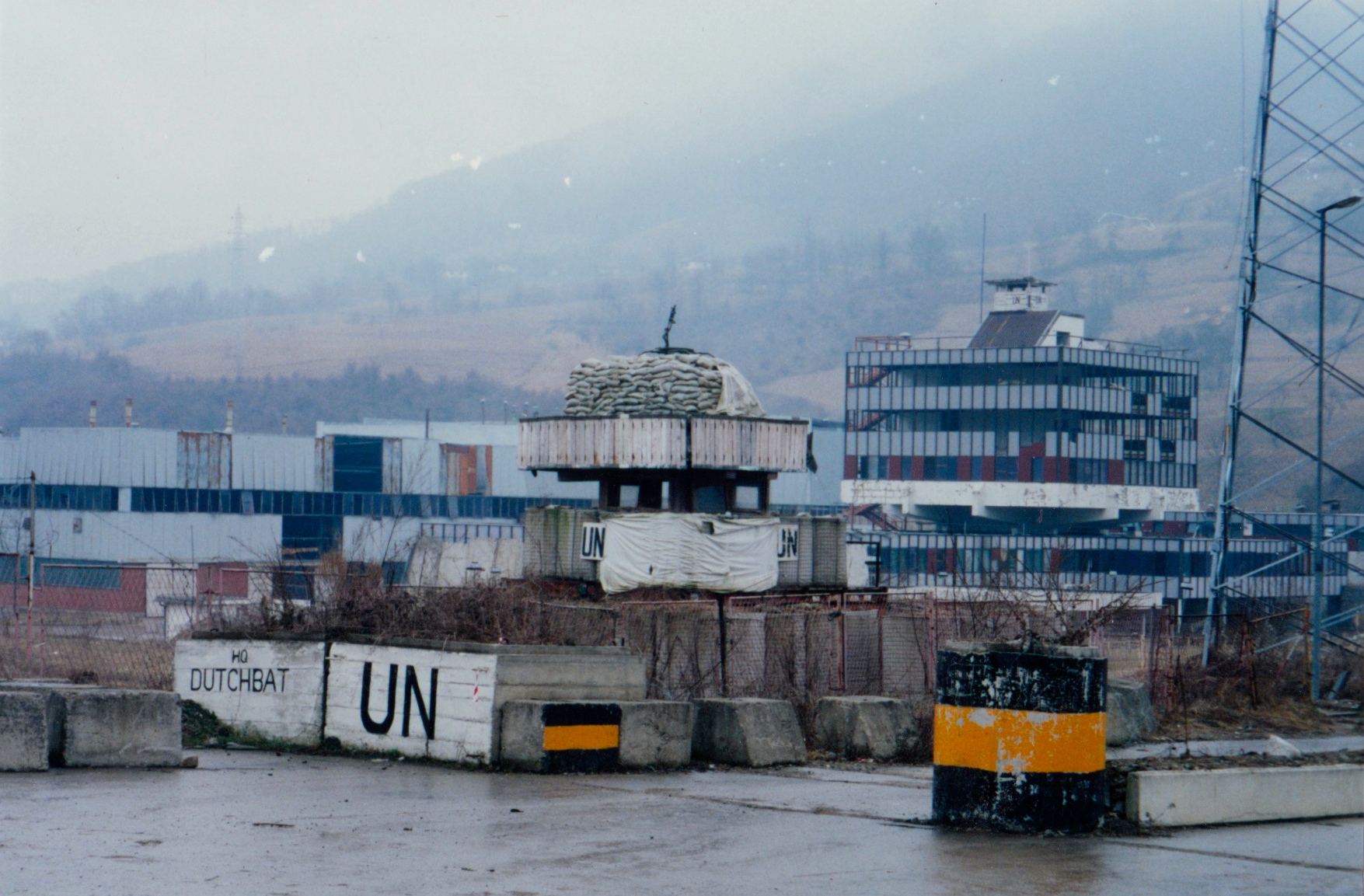
At Potocari, we found the houses, factory and the UN base drawn in my notebook by our interviewees Hiba and Hassan. We entered the Dutch UN Battalion base where the refugees first gathered in hope of safety, only to be expelled by the Dutch on the insistence of the Serbs. There were the gates which Hassan’s parents and brother had to leave through, and there was still the red and white striped tape the Dutch had put up for the refugees to walk between when they left the hanger to join the Serbs……
[Later, on the road from Potocari] …..We filmed the spring our 17 year old boy, Enver, was sent to draw water from while his friends were being killed. We found and filmed the house where it took place, and defying logic I stepped off the road in search of evidence…. Everybody, including the local Serbs, said the massacre sites were mined, so I was only prepared to go so far. Mike Spooner [cameraman] and I picked up Muslim identity cards, clothes and bullet cases – plenty of those. The white house mentioned by Enver was gutted – it had been subject to ‘a cleansing’ long before last summer – but he saw Muslim prisoners taken to the second floor… no one has seen them since.
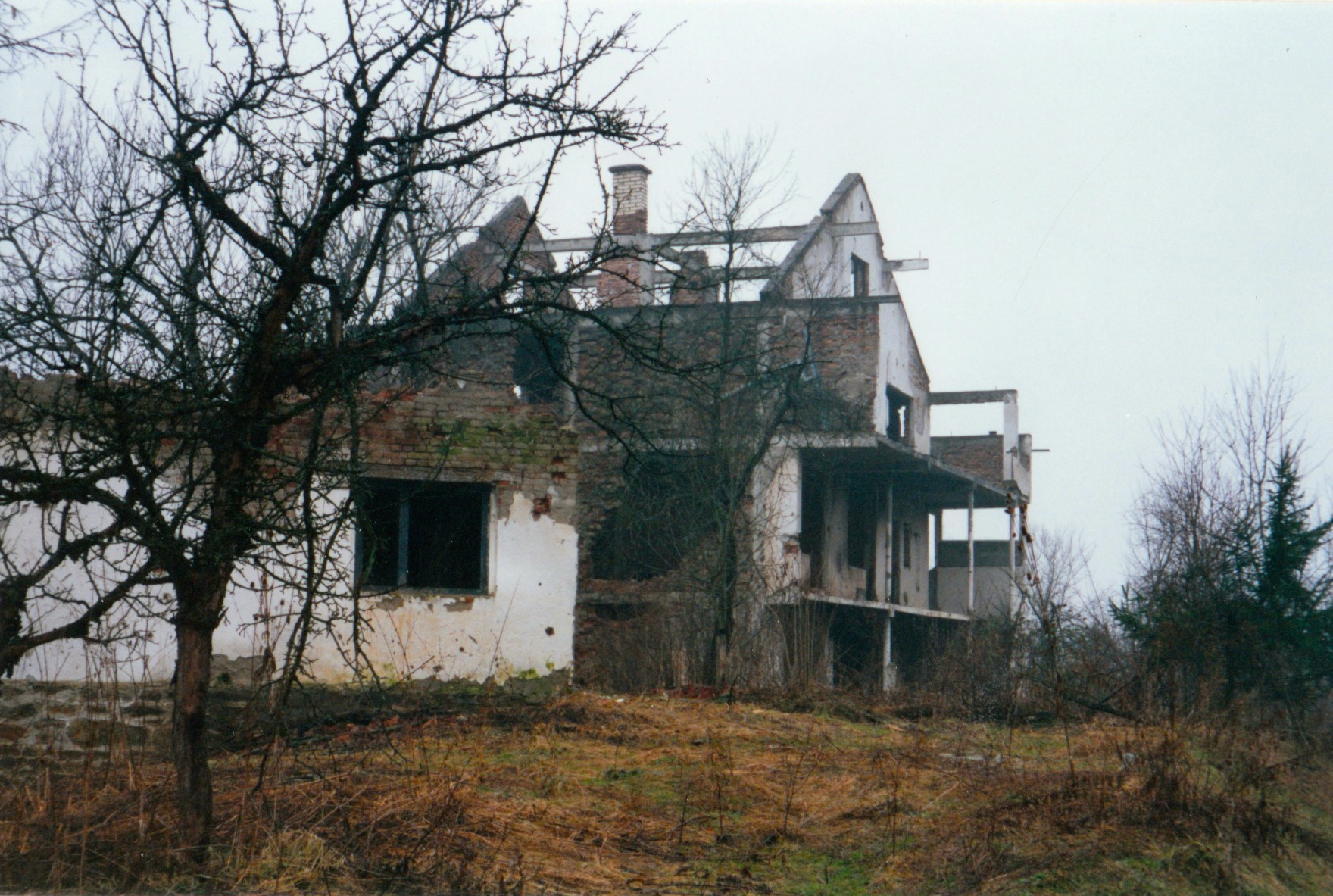
We were watched all the time by plain clothes Bosnian Serb security police. They didn’t try to stop us. Vera was very nervous, in particular, and made Jane and Mike jumpy [me too]. In the end, I spoke to Serbs – they had a little English. They were cool. Even after this though, they refused to leave us, and followed us up the road when we went in search of the site where other prisoners from the hills were rounded up and executed. It is a patch of open ground, littered with clothes, broken syringes [for treating wounds of those injured in shellfire], driving licenses.
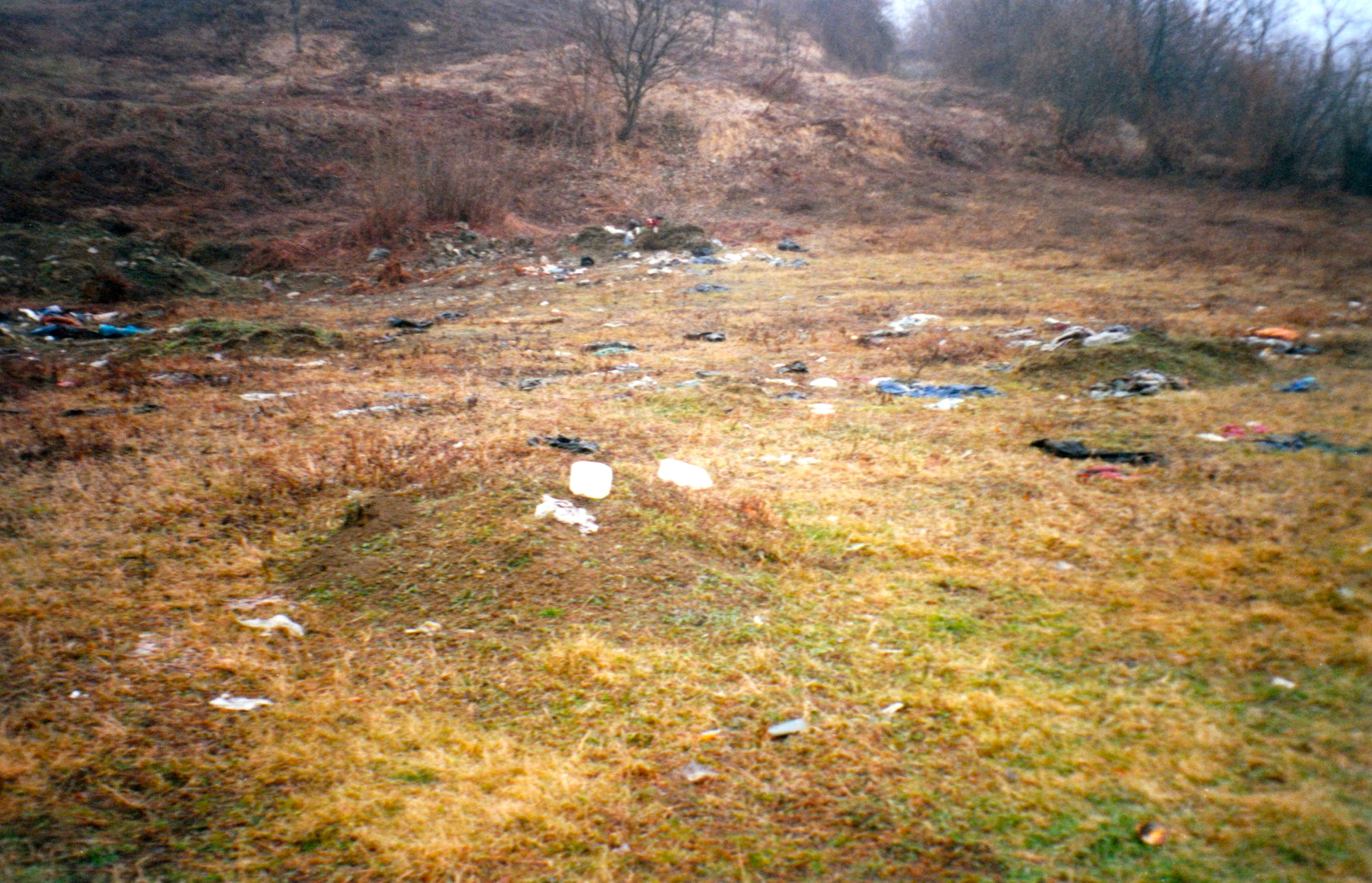
Always, always conscious of mines: Look round the streets of any town in Bosnia and there are men hopping around on crutches….’
Monday, 5th February
‘…Vera has found a friend from the army photographic unit and he has offered to help us shoot the mass grave sites. They are covered in snow and mined and accompanied just by a Pale [Serb] minder the chances of us reaching them are not good. Mike Spooner [cameraman] and I wandered into the old city of Sarajevo at dusk without our flak jackets, although later we heard a sniper at work [which was incredibly stupid!]. We visited the market place where the massacre took place, the pock marked Presidency building and some of the city’s mosques [with plenty of graves from 93 and 94]. My lasting impression was of a city coming back to life. Lighted streets, shops with clothes, food and cafes with patrons: very heartening……’
Tuesday, 6 February 1996. Pale [Bosnian Serb HQ above Sarajevo]
……22.10 Dragan Petrovic [our fixer] has just shouted through to me in the bathroom: ‘the press officer is optimistic, he thinks Karadzic [Radovan Karadžić, Bosnian Serb President, currently on trial for war crimes at the Hague] is going to do the interview. The only problem is the place – he’s just gone into hiding.’ I told Dragan we would wait for the interview and ‘may be we can go out to him in at night or in a closed van’. So old Karadzic has the wind up – of course, everyone was speculating about that…. Today has been a down day and it will only prove worthwhile if we get the interview with Karadzic. Tomorrow, Zoran, the [official] Pale fixer will travel with us to Srebrenica again. He’s a hardliner and filming will be difficult – but we’re going. My one break from the smoke filled, angst ridden BBC house was a brief stroll around Pale at dusk. Some strange looks from the locals. Not much of a town really, just a collection of scattered Alpine houses in snow covered hills and pine forests. Walked to the bottom of the parliament building’s grounds and, because the walk was short, attempted to build a snowman……
From 7 February 1996 [Pale and Srebrenica]
‘……In the end we left from Pale [Bosnian Serb HQ] at 6.30 with Zoran, our Pale minder in tow…. It was a hard three hour drive through heavy snow – I drove the armoured Land Rover, following Zoran’s car….. Srebrenica was completely covered by snow this time. The shellacked houses and the piles of rubbish seemed less sinister under a thick coat of snow. We climbed the hill above the town to the spot where a photo show to us by Hassan of his missing brother was taken. I remembered the graceful minaret in the photo, because Hassan was very keen that we shouldn’t show it; ‘in case it antagonises the Serbs and jeopardises any chance I have of my parents being returned to me’. But the mosque had gone – it’s now a pile of rubble, along with the other mosques in the town.
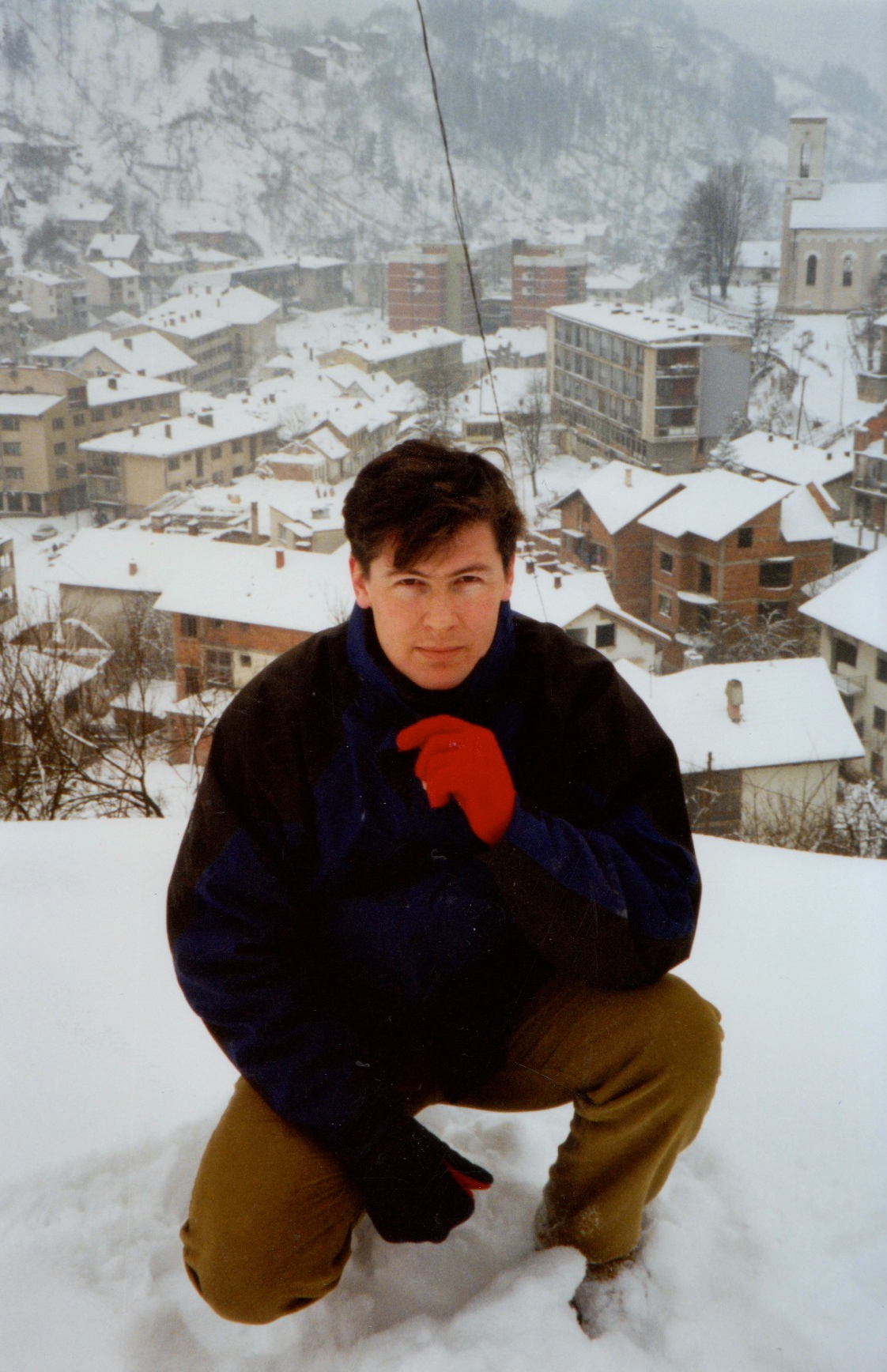
Above Srebrenica
….This time we filmed inside the main warehouse at Potocari where the Bosnian Muslims were held at the base. We tiptoed through the snow, walking only in Zoran’s tracks. Inside the vast hanger those awful few days in July seemed very close. The scattered clothes, unused milk cartons, and of course the red and white tape the Dutch used to section off the Bosnian Muslims was still strung between the pillars. Mike Spooner [cameraman] and I managed to pick up photos of the Muslim families that had been discarded by the refugees, despite Zoran’s watchful gaze. A moving place. We stepped a little gingerly back over the threshold wire, careful to heed the warnings from Zoran and Dragan. A few minutes earlier I’d kicked a discarded milk carton in the warehouse and both men had nearly died with anxiety: ‘God, you mustn’t do that – it could have been mined’. Later in the day we visited Kravica and looked at the bullet holes in the walls of the warehouse where one of our witnesses saw many men killed – and then on to snow covered Glogova.
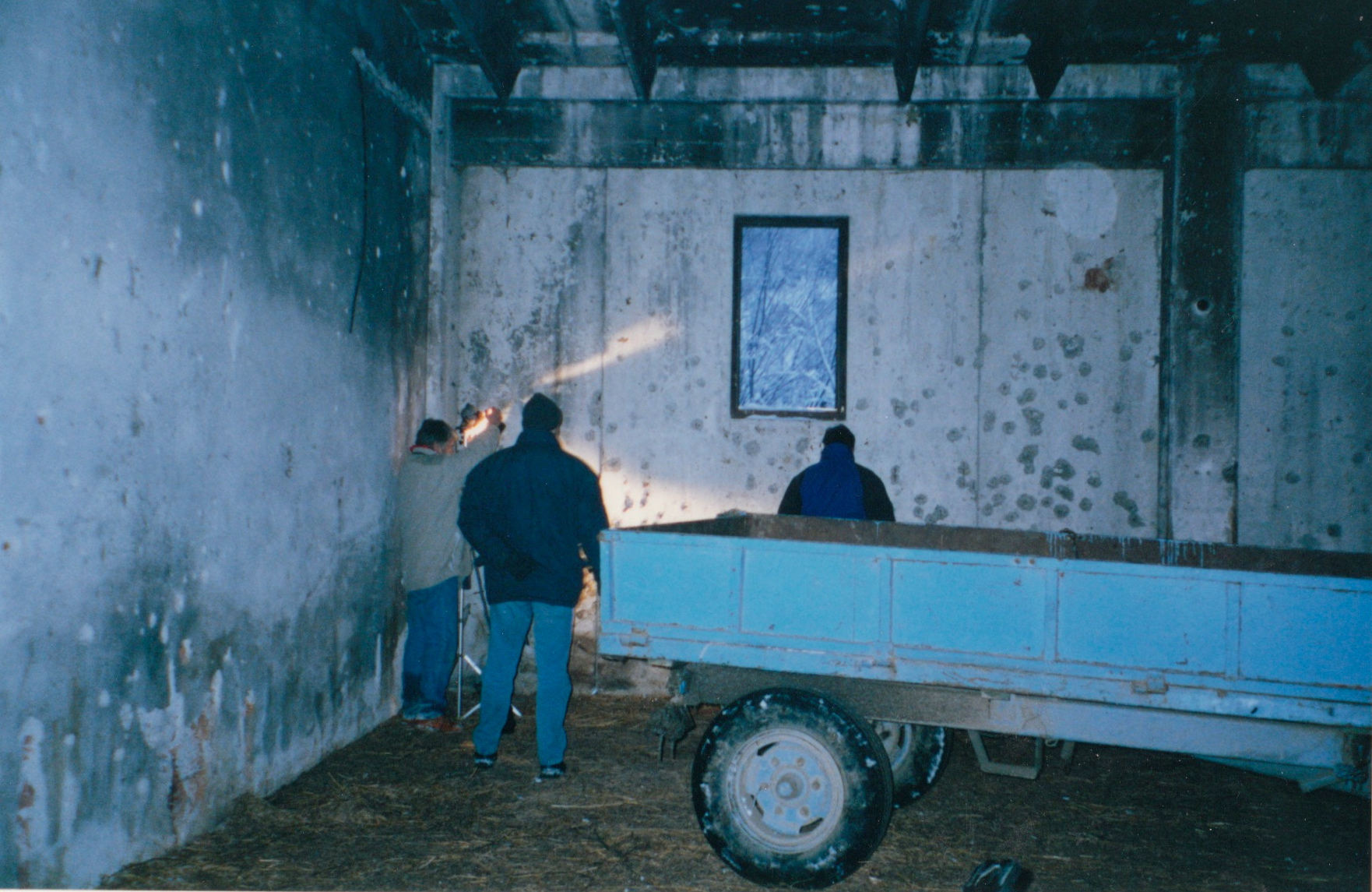
Filming evidence of executions at Kravica
A deserted, ethnically cleansed village, it is supposed to be the site of a mass grave – according to the UK satellite intelligence. [Later transpired the intelligence correct]. It was covered with snow, so we were none the wiser. We’d driven half a mile up the track to the village and had to reverse the Land Rover back in the same tracks. No one wanted to take chances, because the consensus is that the sites are heavily mined…..
The day ended with an exhausting three hour drive back through the night to Pale, the snow so thick it was almost impossible to see the road. Lasting memory of the day? Serb children sledging in front of the demolished mosque in Srebrenica.
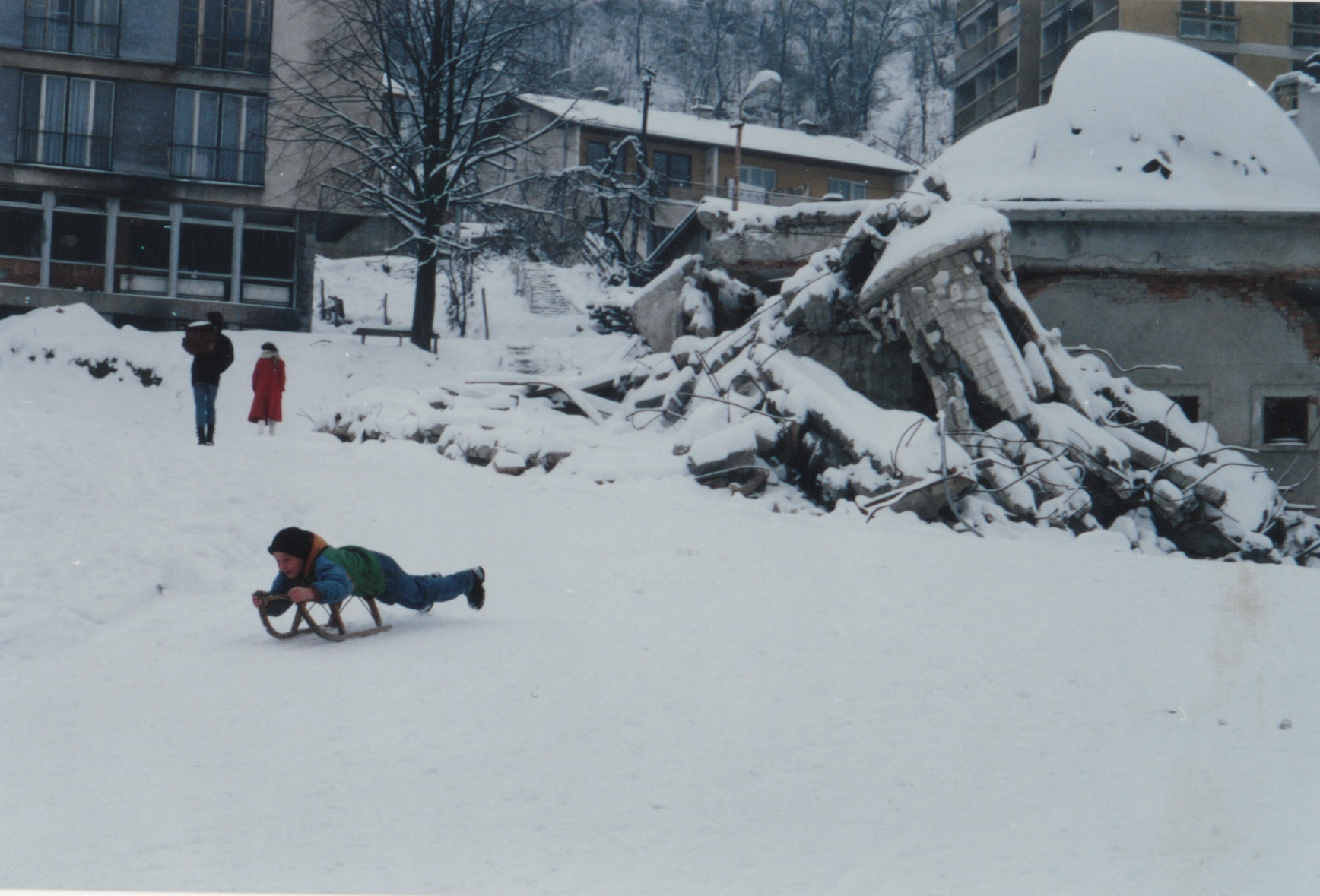
Only a week before I’d seen Muslim children doing the same thing in a village near Tusla. Terrible things were done at Srebrenica, particularly last summer. But the more I learn of the war in Bosnia the more unrealistic I think it is to talk of clear cut war crimes like those committed in the Second World War. This is a village based war between neighbours, ancient hatreds surfacing again, brutal tit for tat killings carried out by a peasant army, sometimes in uniform, sometimes behind the plough. Nevertheless, the size of the slaughter – and of so many prisoners – this is on a different scale altogether.’
